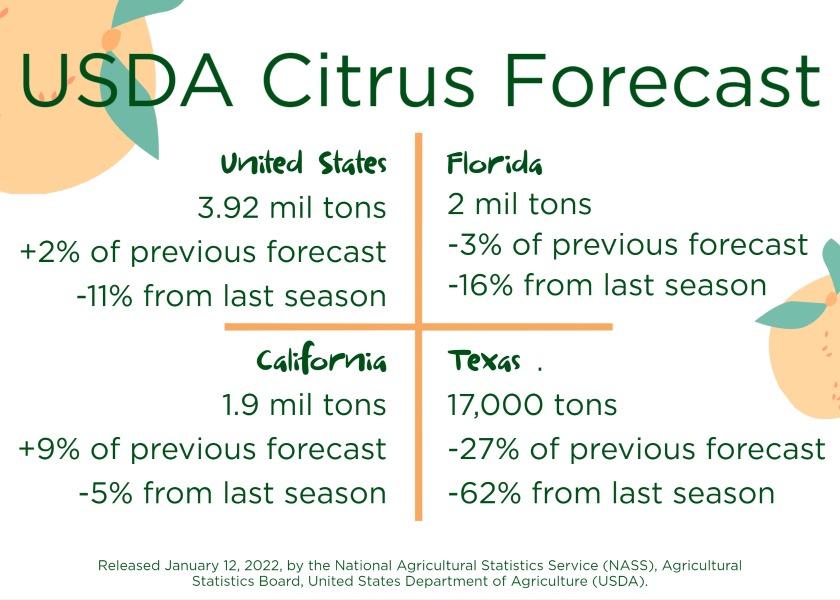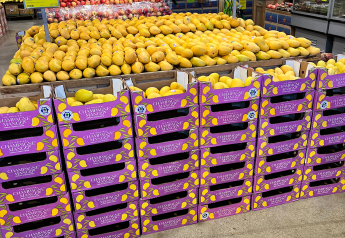Shorter citrus crop brings high demand, strong prices

A revised USDA crop production report in January added to orange crop expectations in California, but supply is still down and prices are up compared with a year ago.
The average fob price for U.S. oranges in mid-January was $22.97 per carton, up 11% from $20.61 per carton the same time a year ago.
The average fob for U.S. grapefruit was $22.20 per carton, up 18% from $18.79 per carton the same time a year ago, according to the USDA website.
Industry leaders have said consumer demand for citrus has remained strong throughout the COVID-19 pandemic, with shoppers interested in foods that can help their immune systems.
There is not quite as much citrus fruit to go around as a year ago, however, despite recent upward revisions in crop estimates.
Revised edition
The USDA crop production report in January said the U.S. all orange forecast for the 2021-22 season is up 2% from the previous forecast but down 11% from the 2020-21 final utilization.
The report said the Florida all orange forecast, at 44.5 million boxes (2 million tons), is down 3% from the previous forecast and down 16% from last season's final utilization. About 90% of Florida’s orange crop is processed into orange juice, crop use numbers show.
The Texas all orange forecast, at 400,000 boxes (17,000 tons), is down 27% from the previous forecast and down 62% from last season's final utilization, according to the report.
California’s all orange forecast is 47.6 million boxes (1.90 million tons), up 9% from the previous forecast but down 5% from last season's final utilization, according to the USDA.
California’s navel orange forecast is 39 million boxes (1.56 million tons), up 11% from the previous forecast but still down 4% from last season's final utilization, the report said.
The state’s valencia orange forecast is 8.60 million boxes (344,000 tons), up 1% from the previous forecast but down 9% from last season's final utilization.
The USDA said the U.S. tangerine and mandarin crop forecast is 878,000 tons, down 1% from the previous forecast and down 25% from the last season's final utilization. California’s tangerine and mandarin forecast, at 21 million boxes (840,000 tons), is unchanged from the previous forecast but down 25% from last year.
Challenging times
Citrus marketers said the season has brought its challenges.
Fresh produce is facing significant supply chain disruptions, labor shortages and increased labor and raw material costs, said Christina Ward, director of global marketing at Sunkist Growers.
Drought conditions and labor challenges are nothing new, but new regulatory challenges are pressing.
“The industry is facing multiple farming challenges,” said Adam Goltz, director of grower relations for Dinuba, Calif.-based Suntreat Packing and Shipping Co. “The rising cost of goods creates management challenges, as well as labor shortage, which increases the cost of labor. There is a big push for sustainable groundwater management along with other regulatory pressures.”
The Sustainable Groundwater Management Act was passed in 2014, with the ultimate goal of mitigating overdraft within 20 years. It was put in place in order to bring groundwater basins into balanced levels of pumping and recharge, according to the California State Water Releases Control Board website.
Though rain and snowfall have been more abundant in recent weeks, earlier drought conditions limited crop potential this season, said Sean Nelson, vice president of sales and marketing at Fresno, Calif.-based Fowler Packing Co.
“Across commodities, the lack of rainfall in the winter of 2020 and 2021 is why there is such a decline in volume in most citrus varieties this season,” he said. “In addition, heavy crop last season led to a much smaller crop set this year. Mandarins are typically alternate-bearing, but it’s more extreme this year.”
January’s USDA crop production estimate from the USDA showed the U.S. grapefruit crop is at 378,000 tons, down 17% from the previous forecast and down 11% from last season's final utilization. The Florida grapefruit forecast, at 4.10 million boxes (174,000 tons), is unchanged from previous forecast and unchanged from the last season.
California's grapefruit forecast, at 3.50 million boxes (140,000 tons), is down 10% from the previous forecast and down 10% from last season.
The Texas grapefruit forecast is down 48% from the previous forecast and down 33% from the 2020-21 season, the USDA said.
The USDA rated the U.S. lemon crop at 976,000 tons, up 9% from the previous forecast and up 10% from last season's final utilization. The USDA said the California forecast, at 23.0 million boxes (920,000 tons), is up 10% from the previous forecast and up 8% from the 2020-21 season. The Arizona forecast, at 1.40 million boxes (56,000 tons), is up 8% from the previous forecast and up 75% from last year.
Trade picture
Despite logistical challenges, U.S. exports of oranges and tangerines increased in the year from December 2020 through November 2021. Value of exports for that period was $697.5 million, up 8% from the same period the previous year.
U.S. exports of lemons for that period, valued at $144 million, were unchanged compared with the previous year.
Grapefruit exports from the U.S. struggled in the period, totaling $53.3 million, down 24% compared with the same period the previous year.
At $189 million, South Korea was the top buyer of U.S. oranges and tangerines from December 2020 through November 2021, up 11% from the same period the previous year.
Canada ($171 million) was the second-biggest buyer of U.S. oranges, followed by Japan ($96 million).
U.S. imports of citrus soared in the period from December 2020 through November, according to USDA statistics. Total citrus imports were $1.581 billion, up 16% compared with the same period the previous year.
Mexico was the top global supplier of citrus to the U.S. market, according to the USDA, with total fresh citrus shipments valued at $671 million, up 27% compared with the previous year.
Chile was the number two supplier, with citrus exports to the U.S. valued at $441 million, which was up 8% compared with the same period the previous year. Peru ($120 million), South Africa ($102 million), Argentina ($71 million), Morocco ($66 million), Uruguay ($35 million), Colombia ($31 million), Australia ($17 million) and Israel ($11 million) also shipped substantial volumes to the U.S.







